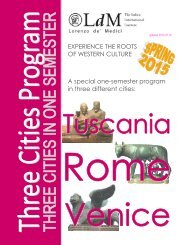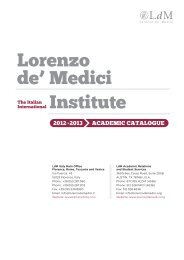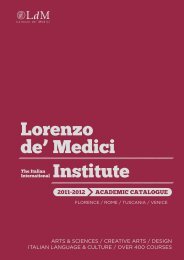aCademiC Catalog 2013-2014 - Lorenzo de Medici
aCademiC Catalog 2013-2014 - Lorenzo de Medici
aCademiC Catalog 2013-2014 - Lorenzo de Medici
Create successful ePaper yourself
Turn your PDF publications into a flip-book with our unique Google optimized e-Paper software.
trends and sales success in retail store spaces. The course<br />
analyses the philosophy behind the creative process and<br />
i<strong>de</strong>ntifies a variety of resources for i<strong>de</strong>a <strong>de</strong>velopment such as:<br />
marketplace dynamics, consumer trends and sales forecasting.<br />
The aim of this course is to prepare stu<strong>de</strong>nts in the process of<br />
<strong>de</strong>signing, planning, budgeting and organizing visual displays<br />
and in store <strong>de</strong>sign that effectively communicate the brand<br />
i<strong>de</strong>ntity. Through lectures stu<strong>de</strong>nts will learn the foundation<br />
techniques regarding visual displays. Through workshops,<br />
stu<strong>de</strong>nts will apply this knowledge to the creation of mock<br />
window displays settings and/or in-store <strong>de</strong>signs. Case studies<br />
will provi<strong>de</strong> a vision of how companies in today’s environment<br />
are adapting visual merchandising strategies to meet the new<br />
consumer’s <strong>de</strong>mand, in terms of <strong>de</strong>sign, visual promotion and<br />
strategies of communication.<br />
Fashion Illustration II<br />
FAS 245 F<br />
Cr: 3; Contact hrs: 90<br />
This is an intermediate level <strong>de</strong>sign course for stu<strong>de</strong>nts who<br />
already have a basic knowledge of fashion <strong>de</strong>sign. Particular<br />
attention will be given to learning and improving fast sketching<br />
of life fashion mo<strong>de</strong>ls, and the ren<strong>de</strong>ring of the fit & fall of<br />
different garments and textures. The fast sketching of mo<strong>de</strong>ls<br />
and garments with the ren<strong>de</strong>ring of different textures is the<br />
base for the <strong>de</strong>velopment of a personal style in fashion <strong>de</strong>sign.<br />
At the end of the course stu<strong>de</strong>nts will be able to express <strong>de</strong>sign<br />
i<strong>de</strong>as based on research and creativity and ren<strong>de</strong>r any kind of<br />
garment on the fashion figure and express a stronger personal<br />
style. The professional si<strong>de</strong> will be taken into consi<strong>de</strong>ration<br />
through on site visits to fashion fairs, <strong>de</strong>sign studios and special<br />
exhibitions; also technical drawings will studied and explained<br />
in or<strong>de</strong>r to improve <strong>de</strong>sign skills.<br />
Prerequisites: FAS 160 Fashion Illustration I, or equivalent<br />
Draping I<br />
FAS 250 F<br />
Cr: 3; Contact hrs: 90<br />
Draping, the second of two methods to create a garment,<br />
starts with shaping muslin on the dressform. Stu<strong>de</strong>nts learn<br />
the basic rules of draping and create sample garments like the<br />
basic bodice and the basic skirt, along with dart variations,<br />
princess lines, sleeves and collars. Sewing machines and basic<br />
stitches will also be used to create personal creative projects<br />
from the conceptual phase to the finished garment. Particular<br />
attention is given to the expression of personal style, especially<br />
when executing the final project, which will show the different<br />
elements learned. Accurate working and attention to <strong>de</strong>tail are<br />
necessary to be successful in this course.<br />
Draping I (Summer only)<br />
FAS 251 F<br />
Cr: 3; Contact hrs: 45<br />
Draping, the second of two methods to create a garment,<br />
starts with shaping muslin on the dressform. Stu<strong>de</strong>nts learn<br />
the basic rules of draping and create sample garments like the<br />
basic bodice and the basic skirt, along with dart variations,<br />
princess lines, sleeves and collars. Sewing machines and basic<br />
stitches will also be used to create personal creative projects<br />
from the conceptual phase to the finished garment. Particular<br />
attention is given to the expression of personal style, especially<br />
when executing the final project, which will show the different<br />
elements learned. Accurate working and attention to <strong>de</strong>tail are<br />
necessary to be successful in this course.<br />
Retailing Management<br />
FAS 265 F<br />
Cr: 3; Contact hrs: 45<br />
Un<strong>de</strong>rstanding the retail environment by looking at its history<br />
and new <strong>de</strong>velopments is the objective of this course. Knowing<br />
how a store operates and the formats it can take on will help<br />
the stu<strong>de</strong>nt become a successful retailer. Multi-channel and<br />
international retailing are introduced as well as supply chain<br />
management. Stu<strong>de</strong>nts will also learn the importance of Human<br />
Resources Management and strategic planning as well as retail<br />
strategies.<br />
Prerequisites: FAS 100 Introduction to the Fashion Industry,<br />
or equivalent (or concurrent enrolment), or an introductory<br />
business course<br />
Knitwear<br />
FAS 270 F<br />
Cr: 3; Contact hrs: 90<br />
This course is <strong>de</strong>signed to familiarize stu<strong>de</strong>nts with the knitwear<br />
market in fashion and with the place of knitwear in a mo<strong>de</strong>rn<br />
fashion collection. It has drawing and experimental components.<br />
At the end of the course stu<strong>de</strong>nts will be able to organize and<br />
execute knitwear <strong>de</strong>sign i<strong>de</strong>as following a given brief; they will<br />
be able to make hand-knitted fabrics and garments, and will<br />
have a basic knowledge of the knitwear fashion industry.<br />
Prerequisites: FAS 160 Fashion Illustration I, or equivalent; or<br />
concurrent enrolment<br />
Accessories Design<br />
FAS 280 F<br />
Cr: 3; Contact hrs: 90<br />
This course is <strong>de</strong>signed for stu<strong>de</strong>nts who already have a good<br />
knowledge of fashion <strong>de</strong>sign and a complete overview of the<br />
world of fashion. The course is structured to allow stu<strong>de</strong>nts<br />
to create their own collection portfolio focused on female<br />
accessories <strong>de</strong>sign: bags, shoes, belts and hats. Stu<strong>de</strong>nts will<br />
visit specialized firms and will meet industry professionals.<br />
Particular attention is also given to an up-to-date trend forecast<br />
and to improving drawing and ren<strong>de</strong>ring skills.<br />
Prerequisites: FAS 160 Fashion Illustration I, or equivalent<br />
History of Costume<br />
FAS 285 F<br />
Cr: 3; Contact hrs: 45<br />
Stu<strong>de</strong>nts explore the historic styles of Western dress and<br />
adornment through the ages from the ancient Egyptian period<br />
to the 20th century. Costume is viewed within the period context<br />
and is related to major historical <strong>de</strong>velopments, technology,<br />
production, and the economic situation. Also discussed are the<br />
arts, societal values, events or specific individuals, insofar as<br />
these that can be seen to influence fashions.<br />
Prerequisites: Sophomore standing<br />
Patternmaking II<br />
FAS 290 F<br />
Cr: 3; Contact hrs: 90<br />
Advanced Patternmaking comprehends the following: sleeve,<br />
collar, and neckline variations, gathers, pleats, and flares, lining,<br />
specialty fabrics. There is a brief introduction to one of the<br />
following categories: outerwear, active wear, or evening wear.<br />
Prerequisites: FAS 150 Design Sewing Techniques and FAS 180<br />
Patternmaking I, or equivalents<br />
Fashion Buying Concepts<br />
FAS 300 F<br />
Cr: 3; Contact hrs: 45<br />
Retailing and the fashion business are stimulating, fascinating,<br />
and in a process of continual change. Un<strong>de</strong>rstanding the<br />
dynamics and significance of retail buying concepts will be<br />
critical to the success of anyone interested in buying, selling or<br />
communicating retail consumer fashion products and services.<br />
Stu<strong>de</strong>nts will study fundamentals of fashion buying including<br />
planning, assorting, pricing and purchasing retail fashion<br />
inventories. The effect of different retail formats on purchasing,<br />
i<strong>de</strong>ntification and evaluation of resources and discussions on<br />
ethical issues in sourcing are inclu<strong>de</strong>d. With global fashion<br />
industry constantly un<strong>de</strong>rgoing change, an important part of<br />
this class involves un<strong>de</strong>rstanding current events and how they<br />
affect retail buying. This inclu<strong>de</strong>s the luxury as well as other<br />
sectors of the industry, mass market brands and in<strong>de</strong>pen<strong>de</strong>nts.<br />
The course is targeted towards stu<strong>de</strong>nts who are looking for<br />
careers in fashion buying, merchandising, marketing, <strong>de</strong>sign,<br />
advertising or public relations and should have already taken<br />
classes towards these majors. The ability to work in teams and<br />
communicate orally is strongly emphasized.<br />
Note: prior fashion retailing and marketing knowledge are<br />
beneficial<br />
School of Design FLORENCE<br />
LdM Aca<strong>de</strong>mic <strong>Catalog</strong> <strong>2013</strong>-<strong>2014</strong><br />
107





